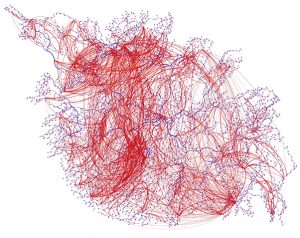
Four professors in the Department of Electrical and Computer Engineering (ECpE) at Iowa State University recently received a $1 million award from the Department of Energy (DOE) for their proposal improving the efficiency of power systems and power lines across America.
Zhaoyu Wang, Harpole-Pentair Assistant Professor and the PI (principal investigator) of the project, is working with ECpE professors and researchers Chinmay Hegde, Assistant Professor; Ian Dobson, Sandbulte Professor of Engineering; and Venkataramana Ajjarapu, David C. Nicholas Professor of Electrical Engineering on this project.
The team’s proposal revolves around the reliability and resiliency of the power lines seen when coasting down Iowa highways, the same power lines allowing people to charge their phones, laptops and computers. While these power lines are currently resilient enough to function well, there are still times when the power lines fail, causing several outages in cities, towns and homes. The ECpE team’s proposal addresses this fault — and is planning on using machine learning to take preventive measures and potentially catch power system failures before they happen.
“Everyone needs electricity,” Wang said. “Right now electricity and the power systems work, but we still have outages. The outages are due to many reasons; for example, extreme weather or even human error. With machine learning, we can reduce the risk of outages and have more of a warning before something bad may happen, allowing people to take immediate action and prevent this from happening.”
Machine learning is a form of artificial intelligence used in computer systems to perform and complete tasks with consistent instruction. The team proposes the use of machine learning in power systems to more accurately predict and prevent faults in the system.
“Machine learning could help us retain data and find hidden information from the data,” Wang said. “When using machine learning, you can quickly understand things from the data provided. But if the machine has this experience, it might make a much faster and accurate decision than the operator based on human experience.”
As of now, humans can discover and analyze data from previous power system faults. But with the ECpE team’s proposal, scientists will be able to analyze the “near misses” and therefore have a much larger data pool, according to Dobson, a co-principal investigator in the project focusing on developing an analysis for the “almost” faults.
“Large blackouts are rare, but when there is a large blackout of the grid, usually one transmission line goes out, then another goes out, and so on” Dobson said. “It’s a whole succession of unusual events. We are trying to get a better handle on these complicated interactions and increase awareness of what happens inside the grid. By being able to see the near misses as well as the outages and faults, we can more accurately see the interactions inside the grid that can cause large blackouts.”
The team is partnering with IBM, Google Brain and an electric power group to help analyze the data.
“By collaborating with other industry partners, we can be sure that this project is practical and of interest to the industry. Not only the power industry, but also the computer engineering part,” Wang said.
The first thing the team plans to do with the $1 million grant is receive data from industries. Since there is so much data, the team is using a portion of the grant money to store data and discover how to access certain data quickly.
“The very first thing we want to do is make sure the data is secure, and then we will pre-process the data, removing bad data and outliers,” Wang said. “Then we will begin the research part using machine learning to analyze the clean data.”
The team has received two other grants directly from the DOE in the past.
“I think this project is exciting because this may be the first time DOE is really involved in machine learning,” Wang said. “Machine learning has been a very popular and hot topic in the past few years, and it has been used for many industry applications.”
This project could potentially prevent power outages across America, with machine learning discovering how “almost misses” happen, and therefore preventing the near misses and full power system faults.